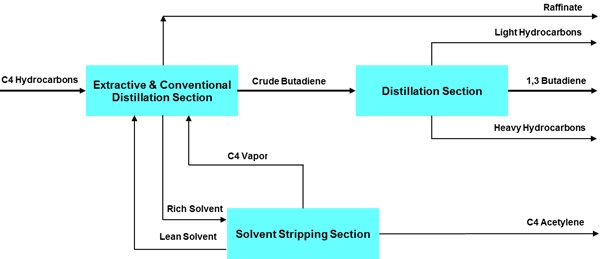Butadiene (BD)
Summary
1,3-Butadiene is generally recovered from mixed C4 hydrocarbons which are consisted of 1,3-butadiene, 1,2-butadiene, butanes, butenes and acetylenes. The 1,3-butadiene separation is accomplished by extraction from the mixed C4 hydrocarbons. There are several extraction processes and the processes are similar to each other basically. Each process to extract the butadiene has a unique extraction process depending on the solvent being used.
Features
The Butadiene Extraction Unit of the extraction process is designed to separate the mixed C4 hydrocarbons into two primary product streams - Crude 1,3-Butadiene and Raffinate - using a solvent. The extraction processes are mainly consisted of Extractive and Conventional distillations, Solvent Stripping Section and Distillation Section.
Extractive and conventional distillation Section
Mixed C4 hydrocarbon vapor stream is fed to the extractive and conventional distillation and crude 1,3-butadiene stream and raffinate stream are separated in the section.
Solvent Stripping Section
The solvent laden with C4 hydrocarbons from the extractive and conventional distillation Section which is rich solvent is stripped into lean solvent in this section. The lean solvent is returned to the extraction and conventional distillation section. To minimize energy consumption, the hot lean solvent from the stripper is utilized as a heating medium at several heat exchangers before entering the extraction column.
Distillation section
The crude 1,3-butadiene contains propyne, 1,2-butadiene and C5 components and 1,3-butadiene as a final product is separated and purified passing through several conventional columns. Light components with propyne and heavy components with 1,2-butadiene are separated from the columns.

